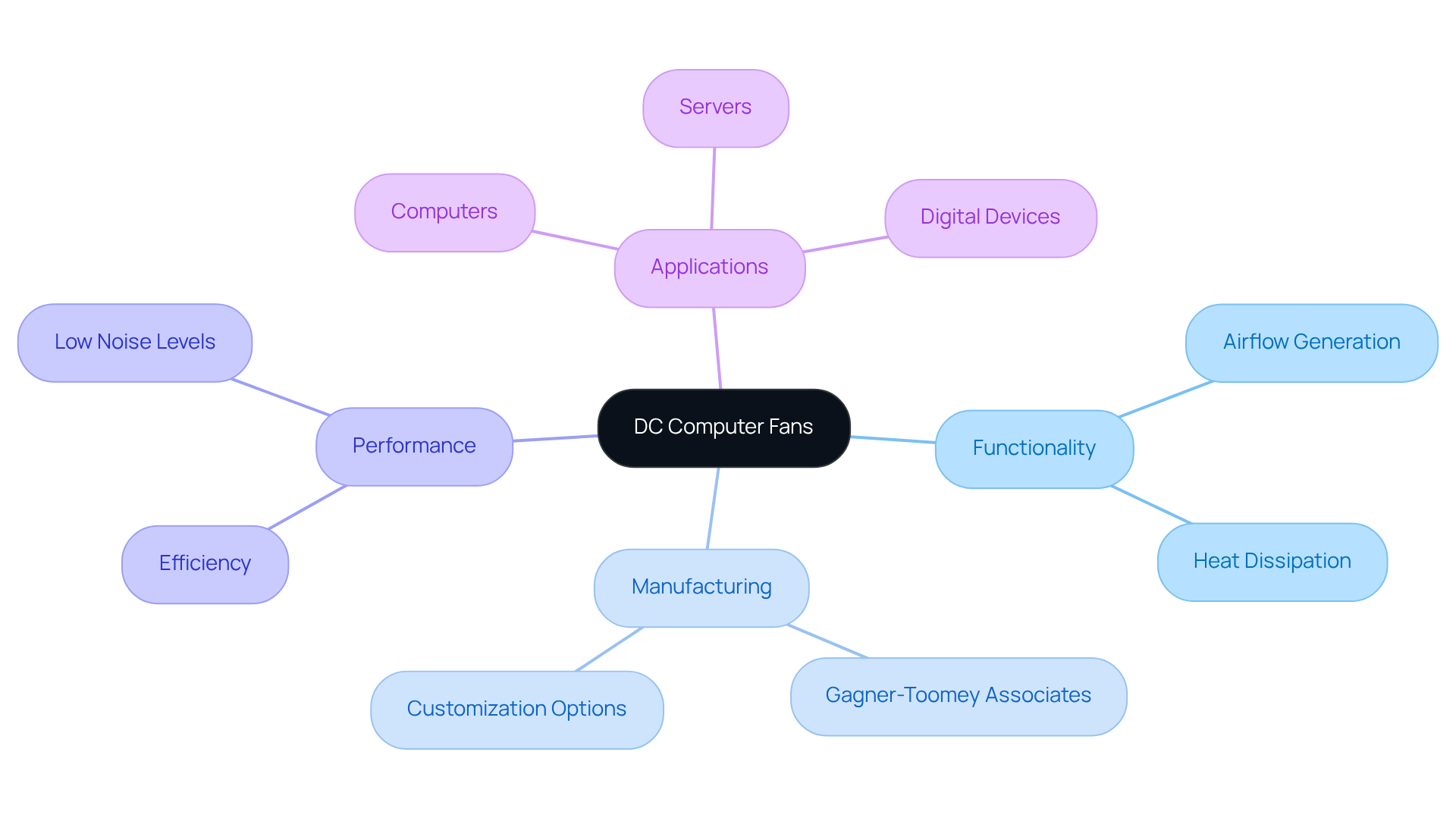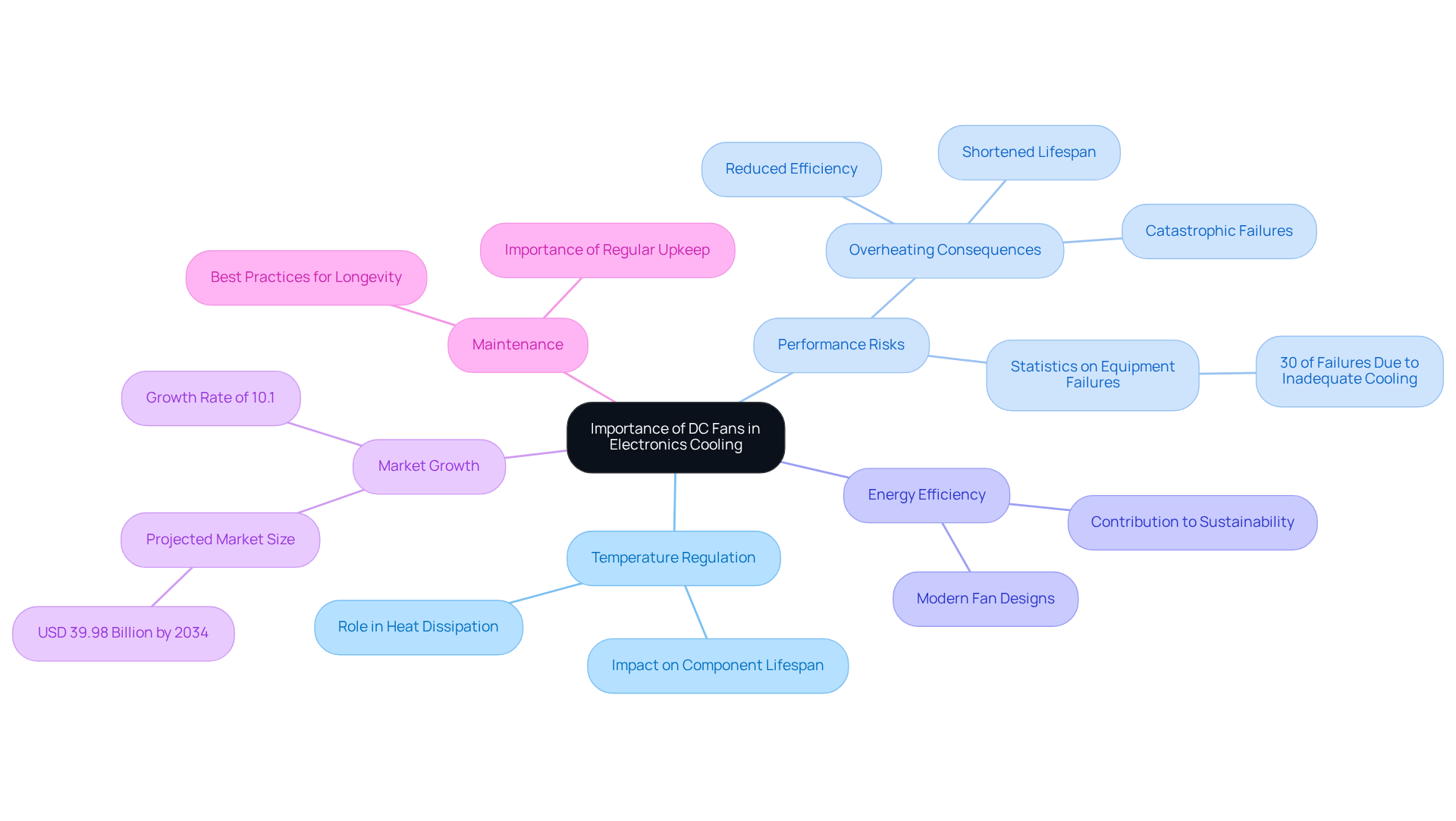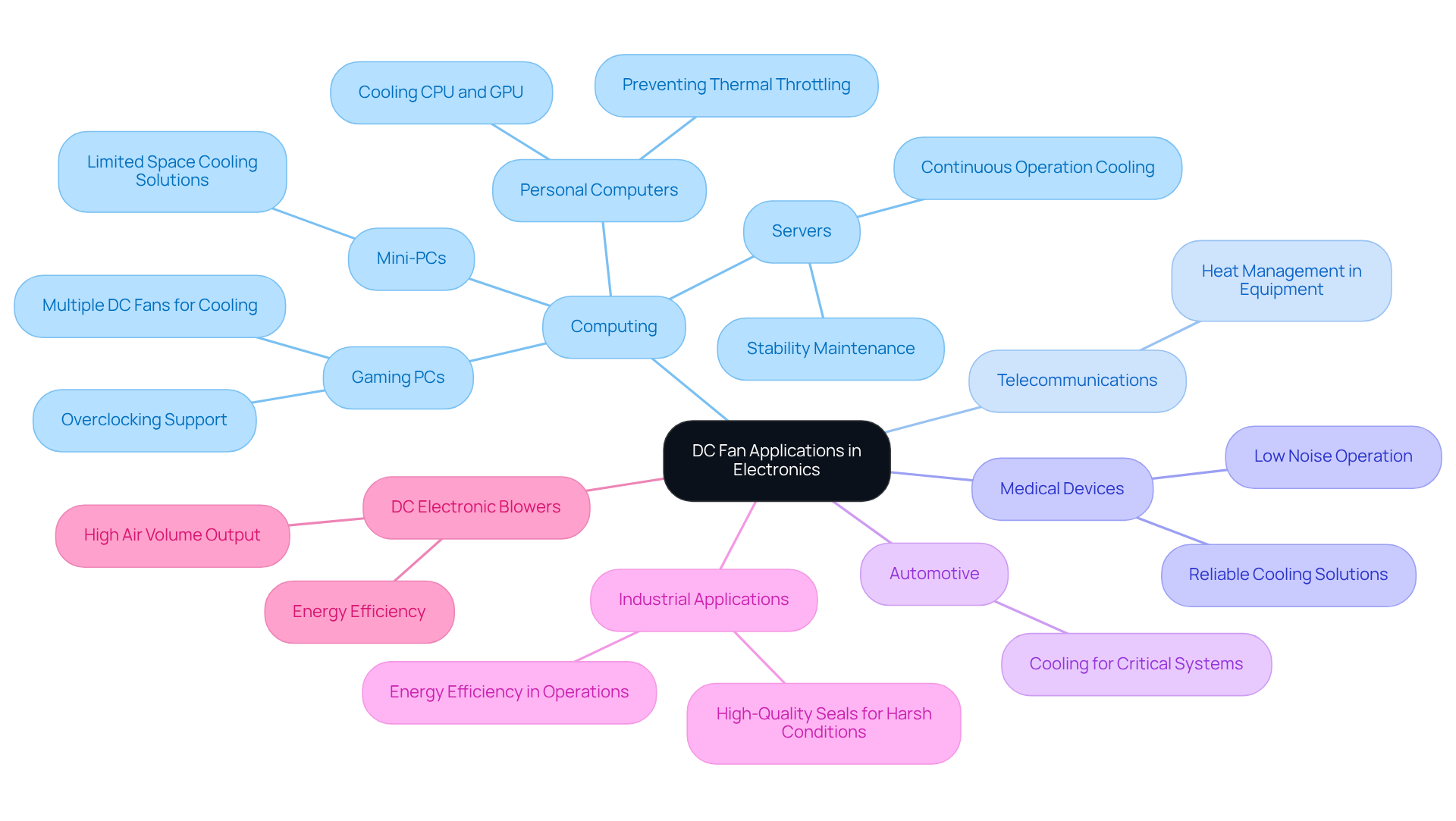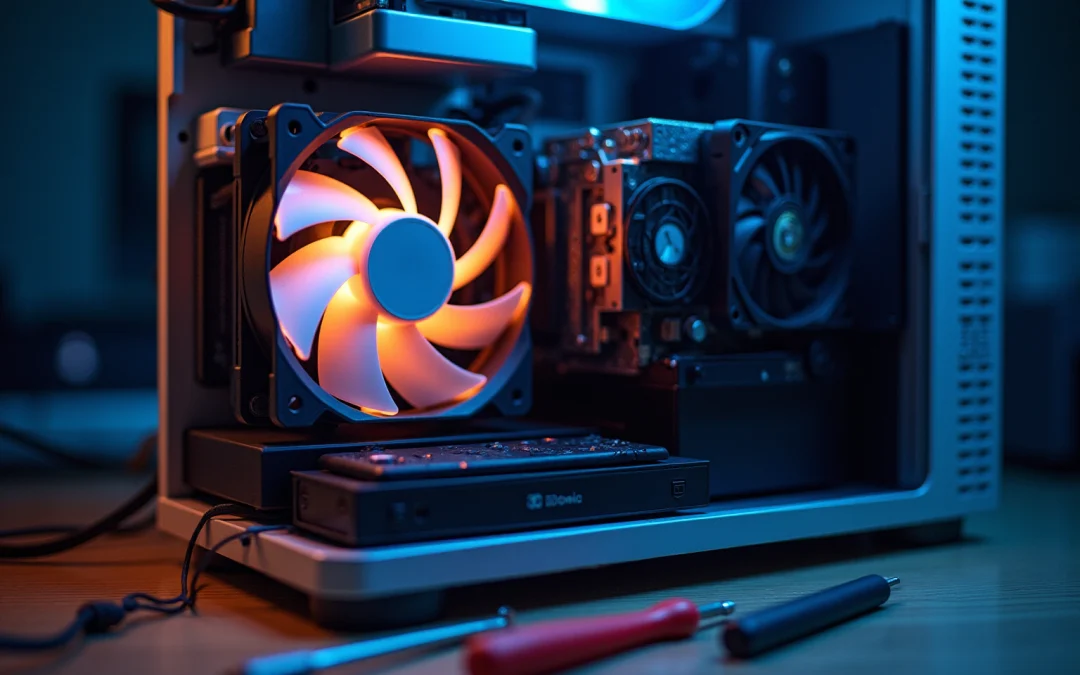Overview
DC computer fans play a vital role in maintaining optimal operating temperatures within electronic devices by effectively dissipating heat generated by components such as CPUs and GPUs. This function is essential for preventing overheating and potential failures, which can compromise device performance and reliability.
The article underscores the significance of DC computer fans through:
- Detailed technical specifications
- Diverse applications across various industries
- The energy efficiency of modern designs
By highlighting their critical role in enhancing both performance and longevity in electronics, it advocates for their indispensable presence in contemporary technological environments.
Introduction
DC computer fans serve as the unsung heroes of electronic devices, diligently operating behind the scenes to sustain optimal performance and avert overheating. These vital components not only guarantee the longevity of critical hardware but also enhance energy efficiency in our increasingly technology-driven world.
Yet, with a vast array of specifications and applications available, how does one identify the best fan for a specific requirement? This article examines the crucial role of DC fans in electronics, investigating their functionality, significance, and varied applications across multiple industries, while also addressing the challenges associated with selecting the appropriate model for effective thermal management.
Define DC Computer Fans and Their Functionality
DC (Direct Current) computer blowers are essential electrical devices designed to harness direct current for effective airflow, primarily aimed at cooling electrical components.
Manufactured by Gagner-Toomey Associates, recognized as the globe’s , these devices are meticulously optimized for performance, efficiency, and low noise levels, making them particularly suitable for sensitive technological applications.
They function by converting electrical energy into mechanical energy, which in turn spins blades to generate airflow. The primary function of DC computer fans is to dissipate heat generated by electrical components, thereby ensuring optimal operating temperatures and preventing overheating.
Gagner-Toomey Associates offers an extensive range of DC computer fans, including DC input tube axial blowers with sizes ranging from 15 to 280mm, tailored for various applications such as computers, servers, and other digital devices, where effective temperature management is crucial for performance and longevity.
Furthermore, numerous models are available with IP protection upon request, significantly enhancing their adaptability to diverse operational environments.

Explain the Importance of DC Fans in Electronics Cooling
DC computer fans play a crucial role in the efficient regulation of temperature in electronic devices, ensuring that ideal operating conditions are maintained. Overheating poses a significant threat to performance, potentially leading to reduced efficiency, a shortened lifespan, and catastrophic failures of critical components such as CPUs, GPUs, and power supplies. A study conducted by the National Electrical Manufacturers Association reveals that over 30% of electrical equipment failures are attributed to inadequate cooling, highlighting the necessity of effective thermal management.
In high-performance computing environments, where heat generation is substantial, DC computer fans deliver consistent airflow that effectively dissipates heat, keeping components within safe temperature ranges. Case studies demonstrate that the implementation of DC blowers can significantly reduce instances of overheating, thereby extending the lifespan of circuit components.
Additionally, the energy efficiency of modern DC computer fans contributes to overall energy savings, positioning them as essential elements in contemporary electronic design and pivotal factors in promoting sustainability within the industry. Regular maintenance of DC units is imperative to ensure their optimal performance and longevity, further enhancing their effectiveness in .
As the thermal management market is projected to grow to USD 39.98 billion by 2034, the demand for efficient temperature control solutions in the electronics sector continues to escalate.

Discuss Technical Specifications and Variations of DC Fans
DC computer fans come in various sizes, forms, and specifications, each meticulously designed to address specific temperature management needs. The key technical specifications to consider include:
- Airflow (measured in cubic feet per minute, CFM)
- Static pressure (measured in inches of water)
- Noise level (measured in decibels)
- Power consumption (measured in watts)
Among the variations of DC blowers:
- Axial types move air parallel to the shaft
- Centrifugal types direct air perpendicular to the shaft
Each type presents distinct advantages; for instance, axial models typically exhibit greater efficiency for general cooling applications, while centrifugal units excel in scenarios that necessitate higher static pressure. Understanding these specifications is crucial for selecting the .

Provide Examples of DC Fan Applications in Electronics
DC devices are employed across a diverse array of electronic applications, underscoring their versatility and importance. In personal computers, DC computer fans play a vital role in regulating the temperature of the CPU and GPU, preventing thermal throttling during intensive tasks. In server environments, multiple DC coolers function in concert to maintain optimal temperatures within densely populated racks. Additionally, DC enthusiasts find their place in consumer electronics such as gaming consoles, where effective temperature management is crucial for performance. Mini-PCs, with their limited space for heat dissipation, require efficient DC computer fans to ensure proper temperature regulation.
Beyond computing, DC enthusiasts are integral to telecommunications equipment, medical devices, and automotive applications, where they aid in heat management of critical systems. Industrial computers utilize DC enthusiasts equipped with high-quality seals and robust construction to ensure reliable performance under harsh conditions. Their capacity to deliver renders them essential in contemporary electronics.
Furthermore, DC electronic blowers are designed to consume less energy while maintaining equivalent air volume output, thanks to high-efficiency motor design, thus enhancing their attractiveness in energy-conscious applications. The consensus among engineers is unequivocal: the reliability and energy efficiency of DC computer fans make them indispensable in modern electronics, significantly contributing to thermal management and overall system performance.

Conclusion
DC computer fans are vital components within electronic devices, primarily serving the essential function of managing heat to ensure optimal performance and longevity. By converting electrical energy into mechanical energy, these fans facilitate effective airflow that dissipates heat generated by critical components, thereby preventing overheating and potential failures.
The article highlights several key aspects of DC fans, including their functionality, importance in cooling, technical specifications, and diverse applications. It emphasizes how these fans contribute to energy efficiency and sustainability, particularly in high-performance computing environments where effective thermal management is crucial. Furthermore, the exploration of different fan types and their respective advantages underscores the significance of selecting the right fan for specific applications.
Ultimately, the significance of DC computer fans extends beyond mere cooling; they are integral to the reliability and efficiency of modern electronic systems. As the demand for effective temperature control solutions continues to grow, understanding and utilizing DC fans becomes increasingly important. Embracing these technologies not only enhances device performance but also promotes sustainability within the electronics industry, urging manufacturers and consumers alike to prioritize effective thermal management strategies.
Frequently Asked Questions
What are DC computer fans?
DC computer fans are electrical devices designed to use direct current to create airflow, primarily for cooling electrical components.
Who manufactures DC computer fans?
DC computer fans are manufactured by Gagner-Toomey Associates, which is recognized as the largest producer of both standard and custom air-movers globally.
What is the primary function of DC computer fans?
The primary function of DC computer fans is to dissipate heat generated by electrical components, ensuring optimal operating temperatures and preventing overheating.
How do DC computer fans work?
DC computer fans convert electrical energy into mechanical energy, which spins blades to generate airflow.
What sizes do DC computer fans come in?
Gagner-Toomey Associates offers DC computer fans in sizes ranging from 15 to 280mm.
What applications are DC computer fans used for?
DC computer fans are used in various applications, including computers, servers, and other digital devices where effective temperature management is crucial.
Are there options for enhanced protection in DC computer fans?
Yes, numerous models of DC computer fans are available with IP protection upon request, enhancing their adaptability to diverse operational environments.

